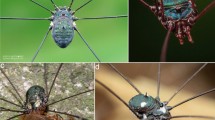Summary
The lateral and posterior adhesive organs of an undescribed species ofNeodasys can be seen by electron microscopy to have only one gland cell type. This gland has dense spherical secretion granules like secretion granules of the viscid glands of other gastrotrichs, and it extends to the exterior through a tubular extension of the animal's cuticle, the adhesive tubule, as in other gastrotrichs. Each adhesive gland ofNeodasys has a prominent striated rootlet that extends through its full length, attaching at its distal end to a basal-body-like structure at the tip of the gland's neck. Unlike other gastrotrichs,Neodasys has no second gland type that would be equivalent to a releasing gland. The lateral adhesive organs have a sensory cell closely associated with the gland cell but not in direct communication with the lumen of the tubule; it bears a single cilium that projects alongside the adhesive tubule. The posterior adhesive organ has adhesive gland cells whose necks reach to adhesive tubules on toe-like extensions of the animal's body; sensory cells here are not in a one-to-one association with the tubules; a secretory myoepithelial cell extends to the tip of each toe. The adhesive organs ofNeodasys are interpreted as being of a form that would have been found in a common ancestor to the gastrotrichs and from which the duo-gland organs of other gastrotrichs might have been derived.
Similar content being viewed by others
Abbreviations
- at:
-
adhesive tubule
- c:
-
basal body
- gcb:
-
gland cell body
- lm:
-
longitudinal muscle
- r:
-
striated rootlet
- sc:
-
sensory cilium
- scb:
-
sensory cell body
- smc:
-
secretory myoepithelial cell
References
Adams, P.J.M., Tyler, S.: Hopping locomotion in a nematode: Functional anatomy of the caudalgland apparatus ofTheristus caudasaliens sp. n. J. Morphol.95, 1–15 (1980) (in press)
Dickson, M.R., Mercer, E.H.: Fine structure of the pedal gland ofPhilodina roseola (Rotifera). J. Microsc. (Paris)5, 81–90 (1966)
Lippens, P.L.: Ultrastructure of a marine nematode,Chromadorina germanica (Beutschli, 1874). I. Anatomy and cytology of the caudal gland apparatus. Z. Morph. Tiere78, 181–192 (1974)
Martin, G.G.: The duo-gland adhesive system of the archiannelidsProtodrilus andSaccocirrus and the turbellarianMonocelis. Zoomorphologie91, 63–75 (1978)
Remane, A.: Neue Gastrotricha Macrodasyoidea. Zool. Jahrb. Abt. Syst. Oekol. Geogr. Tiere54, 203–242 (1927)
Remane, A.: Gastrotricha. Bronns Kl. Ordn. Tierreichs4 (2), 1–242 (1936)
Remane, A.:Neodasys uchidae nov. spec., eine zweite Neodasys-Art (Gastrotricha Chaetonoidea) Kiel. Meeresforsch.17, 85–89 (1961)
Reuter, M.: Scanning and transmission electron microscopic observations on surface structures of three turbellarian species. Zool. Scr.7, 5–11 (1978)
Rieger, R.M.: Monociliated epidermal cells in Gastrotricha: significance for concepts of early metazoan evolution. Z. Zool. Syst. Evolutionsforsch.14, 198–226 (1976)
Rieger, R., Tyler, S.: The homology theorem in ultrastructural research. Am. Zool.19, 655–666 (1979)
Ruppert, E.E.: Zoogeography and speciation in marine Gastrotricha. Mikrofauna Meeresboden61, 231–251 (1977)
Salisbury, J.E., Floyd, G.L.: Calcium-induced contraction of the rhizoplast of a quadriflagellate green alga. Science202, 975–977 (1978)
Tyler, S.: Comparative ultrastructure of adhesive systems in the Turbellaria. Zoomorphologie84, 1–76 (1976)
Tyler, S.: Ultrastructure and systematics: an example from turbellarian adhesive organs. Mikrofauna Meeresboden61, 271–286 (1977)
Tyler, S., Rieger, G.E.: Adhesive organs of the Gastrotricha. I. Duo-gland organs. Zoomorphologie95, 1–15 (1980)
Author information
Authors and Affiliations
Additional information
This research was supported by NSF grants DEB-77-06058 (S. Tyler, P.I) and GB 42211 (R.M. Rieger, P.I.)
Rights and permissions
About this article
Cite this article
Tyler, S., Melanson, L.A. & Rieger, R.M. Adhesive organs of the gastrotricha. Zoomorphologie 95, 17–26 (1980). https://doi.org/10.1007/BF01342231
Received:
Issue Date:
DOI: https://doi.org/10.1007/BF01342231




